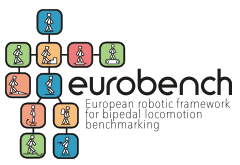
The EUROBENCH project is driven by five global objectives:
- Achieving an international consensus in the industrial and academic community on the requirements for robotics benchmarking in Europe.
- Identifying a scientific method to quantitatively assess the system abilities of bipedal robots and establish the causal relationships with the technologies composing them.
- Providing practical tools to industry and academy to efficiently test robotic platforms at any stage of development, from early prototyping to commercial products.
- Achieving an effective utilization of the benchmarking methodology in the bipedal robotics community and an efficient transferability to other application domains.
- Creating a sustainable “benchmarking infrastructure” for the European robotics community.
These objectives will lead to the consolidation of a benchmarking ecosystem that will integrate the best technologies nowadays available for the assessment of robotic systems. This ecosystem will be composed of two main parts:
- A Methodological Framework, which will translate all the experimental protocols and processing algorithms into a SOFTWARE SUITE, to allow their application worldwide. The software suite will allow any researcher or developer, in both academic and industrial sectors, to apply benchmarking procedures to a wide range of robotic platforms and laboratory conditions. It will include:
- An interactive application that will help the user in identify which testing methods are most suitable to evaluate the ability of a specific robotic system, as well as a step-by-step guide to run the test experiments in a specific laboratory setting.
- An automatic scoring system that, based on the data recorded from the experiments, will provide a “performance score” of the robotic system according to established benchmarks. Such scoring system can be used to: (i) improve the system from an engineering point of view and (ii) provide the numerical values needed for certification and/or standardization institutions, (iii) compare different solutions, (iv) evaluate key investment indicators and commercial maturity state level.
- A database, which will allow uploading and/or downloading data recorded in other systems (when publicly available), for comparison with the SoA of similar robotic systems. The database will also serve as an interface to access data already stored in pre-existent databases.
- A decisional support system that will i) identify a causal relation between technology capabilities and system ability level, to identify which technical features should be improved to reach a higher level of performance, and ii) predict future levels of system abilities that a robotic system can reach based on similar previous benchmarked systems.
- An Experimental Framework composed of TWO TESTING FACILITIES, one for humanoids and the other for wearable robots, that include all the testing devices necessary to test bipedal systems under a multifaceted perspective. The facilities will be preliminary improved and validated by Third Parties during the project duration thanks to the FSTP Open Calls, and then exploited after the project ending, to provide a sustainable service to companies and research institutions. The main expected services will be:
- Providing Companies and Researchers with experimental infrastructures to test the performance of their bipedal robotic technology, either wearable robots or humanoids, at any stage of development, using state-of-the-art benchmarking tools.
- Providing European projects consortia with fully operative locations to perform trials and demos, to verify and demonstrate the performance of robotic technologies developed in the projects.
- Providing Health Institutions with an engineering-supported experimental site to compare different rehabilitation/assistive technologies.
- Supporting Certification and Standardization entities with state-of-the-art test benches to establish reference values on the different targeted abilities that need to be quantified.
- Offering a demonstration site for Users and Providers, to stimulate the interest in benchmarking and creating connections between the different actors and the potential stakeholders
- Providing Institutions and Organizations with a site for performing competitions of robotic technology, in the field of rehabilitation robotics (exoskeleton, prostheses) and humanoids.
- Constitute a site for cluster meetings between the EUROBENCH consortium and all other entities involved throughout and after the project.
Are you a potential stakeholder interested in using the EUROBENCH framework?
Please fill our survey!

